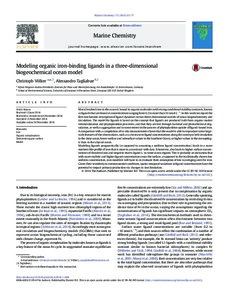Modeling organic iron-binding ligands in a three-dimensional biogeochemical ocean model.

View/
Average rating
votes
Date
2015Author
Völkera, Christoph
Tagliabue, Alessandro
Metadata
Show full item recordAbstract
Most dissolved iron in the ocean is bound to organic molecules with strong conditional stability constants, known as ligands that are found at concentrations ranging from 0.2 to more than 10 nmol L− 1. In this work we report the first mechanistic description of ligand dynamics in two three-dimensional models of ocean biogeochemistry and circulation. The model for ligands is based on the concept that ligands are produced both from organic matter remineralization and phytoplankton processes, and that they are lost through bacterial and photochemical degradation, as well as aggregation and to some extent in the process of phytoplankton uptake of ligand-bound iron.
A comparison with a compilation of in-situ measurements shows that the model is able to reproduce some large-scale features of the observations, such as a decrease in ligand concentrations along the conveyor belt circulation in the deep ocean, lower surface and subsurface values in the Southern Ocean, or higher values in the .....
Journal
Marine ChemistryVolume
173Page Range
pp.67-77Document Language
enEssential Ocean Variables (EOV)
Dissolved organic carbonBest Practice Type
Best PracticeGuide
DOI Original
https://doi.org/10.1016/j.marchem.2014.11.008Citation
Völker, C. and Tagliabue, A. (2015) Modeling organic iron-binding ligands in a three-dimensional biogeochemical ocean model. Marine Chemistry, 173, pp.67-77. DOI: https://doi.org/10.1016/j.marchem.2014.11.008Collections
The following license files are associated with this item:
Except where otherwise noted, this item's license is described as Attribution-NonCommercial-NoDerivs 3.0
 Repository of community practices in Ocean Research, Applications and Data/Information Management
Repository of community practices in Ocean Research, Applications and Data/Information Management
